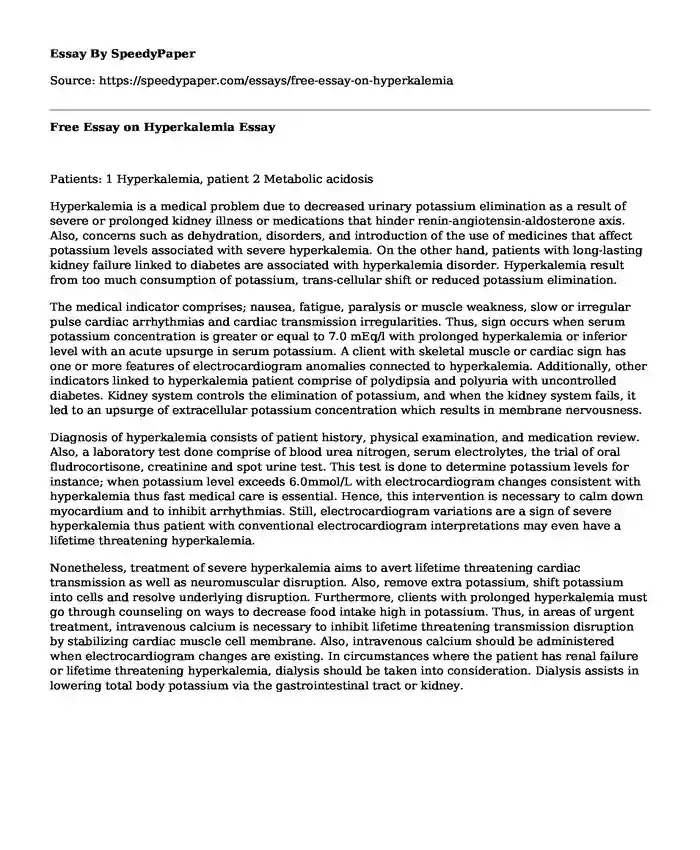Patients: 1 Hyperkalemia, patient 2 Metabolic acidosis
Hyperkalemia is a medical problem due to decreased urinary potassium elimination as a result of severe or prolonged kidney illness or medications that hinder renin-angiotensin-aldosterone axis. Also, concerns such as dehydration, disorders, and introduction of the use of medicines that affect potassium levels associated with severe hyperkalemia. On the other hand, patients with long-lasting kidney failure linked to diabetes are associated with hyperkalemia disorder. Hyperkalemia result from too much consumption of potassium, trans-cellular shift or reduced potassium elimination.
The medical indicator comprises; nausea, fatigue, paralysis or muscle weakness, slow or irregular pulse cardiac arrhythmias and cardiac transmission irregularities. Thus, sign occurs when serum potassium concentration is greater or equal to 7.0 mEq/l with prolonged hyperkalemia or inferior level with an acute upsurge in serum potassium. A client with skeletal muscle or cardiac sign has one or more features of electrocardiogram anomalies connected to hyperkalemia. Additionally, other indicators linked to hyperkalemia patient comprise of polydipsia and polyuria with uncontrolled diabetes. Kidney system controls the elimination of potassium, and when the kidney system fails, it led to an upsurge of extracellular potassium concentration which results in membrane nervousness.
Diagnosis of hyperkalemia consists of patient history, physical examination, and medication review. Also, a laboratory test done comprise of blood urea nitrogen, serum electrolytes, the trial of oral fludrocortisone, creatinine and spot urine test. This test is done to determine potassium levels for instance; when potassium level exceeds 6.0mmol/L with electrocardiogram changes consistent with hyperkalemia thus fast medical care is essential. Hence, this intervention is necessary to calm down myocardium and to inhibit arrhythmias. Still, electrocardiogram variations are a sign of severe hyperkalemia thus patient with conventional electrocardiogram interpretations may even have a lifetime threatening hyperkalemia.
Nonetheless, treatment of severe hyperkalemia aims to avert lifetime threatening cardiac transmission as well as neuromuscular disruption. Also, remove extra potassium, shift potassium into cells and resolve underlying disruption. Furthermore, clients with prolonged hyperkalemia must go through counseling on ways to decrease food intake high in potassium. Thus, in areas of urgent treatment, intravenous calcium is necessary to inhibit lifetime threatening transmission disruption by stabilizing cardiac muscle cell membrane. Also, intravenous calcium should be administered when electrocardiogram changes are existing. In circumstances where the patient has renal failure or lifetime threatening hyperkalemia, dialysis should be taken into consideration. Dialysis assists in lowering total body potassium via the gastrointestinal tract or kidney.
Cite this page
Free Essay on Hyperkalemia. (2022, Apr 15). Retrieved from https://speedypaper.net/essays/free-essay-on-hyperkalemia
Request Removal
If you are the original author of this essay and no longer wish to have it published on the SpeedyPaper website, please click below to request its removal:
- Free Essay: The Changing Face of Healthcare Leadership in the 21st Century
- Free Paper Sample Dedicated to Korean Immigrants
- Business Plan Sample for Northwest Oregon Logging Company
- Essay Sample Dedicated to Effective Business Communication
- Essay Sample on Emotions, Stress and Motivation
- Essay Sample on Facebook's Stock 1Y Performance
- Free Essay on Climate Change Mitigation Policies
Popular categories





